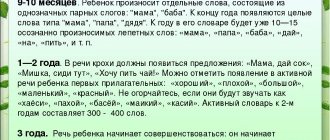Article “Development of speech functions in preschool age”
Olga Alexandrovna Andriyanova
Article “Development of speech functions in preschool age”
Language and speech have traditionally been considered in the psychological, pedagogical, philosophical and social sciences as a “node” in which various lines of mental development of the individual , such as thinking, imagination, memory, emotions, converge. Being the most important means of human interaction, communication, knowledge of reality, language serves as the main channel for introducing the values of spiritual culture from generation to generation, as well as a necessary condition for education and training.
According to A. A. Leontyev, a person’s speech experience does not simply reinforce some conditioned reflex connections, but leads to the appearance in the human body of a speech mechanism, or speech ability. This mechanism is formed in each individual person on the basis of the innate psychophysiological characteristics of the body and under the influence of verbal communication.
In the context of the implementation of the Federal State for preschool education, changes have occurred in traditional approaches to organizing the pedagogical process. This also affected the section of work on speech development .
Each child, in the early stages of his development , first begins to master gestures and movements, and then moves on to the perception and use of sounds, which later become connected speech, taking into account all the rules and traditions accepted in a given ethnic group.
Communication through sounds has its own functions , which emerged gradually and do not reflect the functions of speech . functions of speech in preschool age are distinguished :
1. Communicative function ( communication function )
.
In early childhood, the child uses speech as a means of communication. However, he communicates only with close or well-known people. Communication in this case arises about a specific situation, which includes adults and the child himself. Communication in a specific situation about certain actions and objects is carried out using situational speech ; it is quite clear to the interlocutors, but is usually incomprehensible to an outsider who is not familiar with the situation itself. Situationalism can be represented in speech in a variety of forms. For example, typical for situational speech is the deletion of the implied subject, which is replaced by a pronoun.
As the circle of contacts expands and as cognitive interests grow, the child masters contextual speech. Contextual speech enough to be understandable without direct perception of this situation. A retelling of books, a story about an interesting fact, or a description of an object cannot be understood by the listener without an intelligible presentation. The child begins to make demands on himself and tries to follow them when constructing speech .
A special type speech is explanatory speech. In older preschool age, a child has a need to explain to a peer the content of the upcoming game, the structure of the toy, and much more. Often, even a minor misunderstanding leads to mutual dissatisfaction between the speaker and the listener, to conflicts and misunderstandings. Explanatory speech requires a certain sequence of presentation, highlighting and indicating the main connections and relationships in a situation that the interlocutor must understand. The explanatory type of coherent speech is essential both for the formation of collective relationships among children and for their mental development .
2. Planning function . to perform this function due to the fact that it merges with the child’s thinking. Thinking in early childhood is included in his practical objective activity. As for speech , in the process of solving problems it appears in the form of appeals to an adult for help. By the end of early childhood, in the speech of children who have taken on the solution of any problem, many words appear that seem to be addressed to no one. Partially these are exclamations expressing the child’s attitude to what is happening, partially they are words denoting actions and their results.
3. Intelligent function . At preschool age, speech becomes a child’s instrument of thinking. He learns to express his thoughts coherently and logically; his reasoning turns into a way to solve various intellectual problems. Speech becomes a means of cognition, intellectualization of cognitive processes.
4. Regulatory function . Associated with the development of speech understanding . It is expressed in the understanding of literary works, in subordination and execution of instructions from an adult, and in the influence of the child himself on an adult or peer.
5. Sign function . It is associated with the isolation of a word as an abstract unit, that is, the child’s awareness of the sound structure of a word and the verbal composition of a sentence, which creates the opportunity to make the word an object of knowledge and master written speech.
The development of speech functions in preschool age is carried out in the process of continuous direct educational activity, routine moments, independent activity of pupils, and games.
Thus, the development of speech in a child occurs as a process of mastering his native language, the richness of its vocabulary and grammatical forms necessary for each person to understand other people and the ability to express their thoughts, desires, and experiences. With age an increasingly important role in the general and special speech development of a child. In such forms of communication, the child masters speech as a means of influencing others and himself, as a means of self-knowledge and self-regulation.
Repeat instructions.
One of the important points is the ability to hear and understand verbal instructions. Remember what you do when you receive some kind of instruction to action? You mentally repeat all the stages of the action and carry them out. And you do this automatically, without noticing it at all, because you have inner speech that gives commands for action. This is what you need to teach your child.
Everything is very simple. You told the child: “Take the umbrella and take it to the closet.” And then you ask: “What did I tell you to do?”
Your task is to get the child to repeat the instructions as accurately as possible, or at least name all the stages of the action. This can be done several times throughout the day. Ask the child to repeat after you all your words. Over time, the child will learn to remember more complex instructions, and you will notice that the child carries out your instructions much better.
Functions of a child’s speech article on the topic
Functions of a child's speech.
Native language as a factor of development and education.
A child’s speech performs 3 functions of connecting him with the outside world: communicative, cognitive, and regulating. The communicative function is the earliest: the first word, born from modulated babble in the 9th – 12th month of a child’s life, performs precisely this function. The need to communicate with other people stimulates the improvement of the child’s speech in the future. By the end of 2 years of life, he can already express his desires and observations in words clearly enough for others, and can understand the speech of adults addressed to him. After the age of 3 years, the child begins to master inner speech. From this time on, speech for him ceases to be only a means of communication; it already performs other functions, primarily the function of cognition: by learning new words and new grammatical forms, the child expands his understanding of the world around him, of objects and phenomena of reality and their relationships. In parallel with the development of communicative and cognitive functions, the child begins to assimilate speech as a regulator of behavior. The first words that regulate behavior are the words “you can’t, you can,” verbs in the form of the imperative mood like “eat, go,” etc.
- It is forbidden! - the mother says firmly, taking away the book from the baby, which he is trying to tear.
- The book will leave Vanya and say: “Vanya is bad.” (The essence of the ban is that you cannot handle the book carelessly. If it is torn, it cannot be used.)
Such words awaken the child’s self-awareness, train his will, and discipline him. Discipline and later self-discipline as a personality quality is the key to the development of character traits necessary for a person.
The ability to communicate, explore the world, and the ability to plan one’s actions are formed in a child as the brain develops, but the development process itself largely depends on training, i.e. from constantly reacting to already learned words. When it becomes possible for a child to master language in its regulatory function, this means that the native language has become an instrument of moral education. From now on, adults should be especially attentive to their words and their behavior. The first words that regulate behavior that a child must learn are the words “you can’t, you can, you must,” and with their help he learns the concepts of “good and bad.” The word “can” allows good, kind deeds for the benefit of people, animals, and plants. With the help of the word “must,” the will is trained, the child’s effective attitude towards his duty is brought up: he must do something that he does not want to do at all, he must feed the birds in winter, take care of plants, help his grandmother with housework, he must protect the weak from injustice.
While mastering his native language, the child also perceives its characteristic syntactic structures. Thus, having understood the change in verbs by persons, the child will learn a form of politeness (for example, when addressing a teacher: “What are you reading to us?” or “Can you read to us?” instead of the capricious “Well, read it!”)
When a child understands such words of his native language as kindness, benevolence, responsiveness, caring, truthfulness, hard work, honesty, modesty, loyalty, they will become a program for the formation of his moral principles. The child absorbs their content, i.e. learns to act in accordance with the moral requirements that make up the meaning of these words, he will be able to contrast them with the meaning of antonym words: heartlessness, envy, callousness, inattention, deceit, laziness, dishonesty, boastfulness, infidelity.
Of course, at early stages the child will not utter these words; he will first listen to nursery rhymes, fairy tales, stories, poems in which the characters, by their behavior, show examples of honesty, fidelity, hard work, and service to duty.
The child will want to follow good deeds and will meaningfully learn the words denoting the corresponding moral concepts. A feeling of familiarity with beauty is born in the child; beauty and happiness become synonymous for him! And all this comes from your native language! Resource id #5048
Report: “Higher mental function, speech development”
Report: “Higher mental function, speech development”
Speech
- the most important mental function inherent only to humans. Thanks to verbal communication, the reflection of the world in the consciousness of one person is constantly replenished and enriched by what is reflected in the public consciousness and is associated with the achievements of all social, industrial and cultural activities of mankind. Thus, speech is the basis of the communicative function, which is carried out through a particular language.
Speech disorders and their correction in children with intellectual underdevelopment are determined, first of all, by the close connection between the processes of speech development and the cognitive activity of the child. Deficiencies in phonemic hearing are combined with a slow rate of articulation development. There are violations of the phonemic and grammatical aspects of speech. There is a limited, poor vocabulary, misunderstanding of words, inaccurate use, and a pathological gap between active and passive vocabulary. Schoolchildren with intellectual disabilities mostly use simple sentences and their construction is incorrect.
Speech disorders in children with intellectual disabilities are widespread and characterized by complex pathogenesis and symptoms. Speech defects in such children may be due to underdevelopment of cognitive activity, or may be associated with other factors (hearing loss, impaired speech motor skills, structural anomalies of the articulatory apparatus, etc.). The specificity of speech disorders and their correction is determined by the characteristics of their higher nervous activity and mental development . The structure of speech defects in children with disabilities is determined by the complex interaction of biological and social factors.
Violation of the phonemic aspect of speech
Violations of the phonetic aspect of speech among mentally retarded primary schoolchildren are observed in 40%-60% of all junior students in Type VIII schools. In mentally retarded children, as in normal children, articularly complex sounds are more often disturbed: whistling, hissing, l-l, r-r. Along with the distortion of sounds, there is a large number of substitutions and difficulties in using correct articulatory settings in independent speech. Substitutions are often variable: a mentally retarded child pronounces the same sound correctly in some cases, but misses or distorts it in others, depending on the sound-syllable structure of the word.
Games and exercises for the pronunciation of hissing sounds can be combined thematically. So, after looking at the picture “Hedgehog and Hedgehogs,” the adult asks to complete a number of tasks: clearly pronounce phrases with the sounds “Sh” and “F” (“Sha-sha-sha - we are giving the baby a bath; shu-shu-shu - I’ll give the baby a mushroom; shi-shi-shi - where do the kids walk? or: zha-zha-zha - we saw a hedgehog; zhu-zhu-zhu - we will give the fungus to the hedgehog; zhi-zhi-zhi - where do hedgehogs get mushrooms?"). Such exercises help children master the intonation of a question and develop their sense of rhythm.





